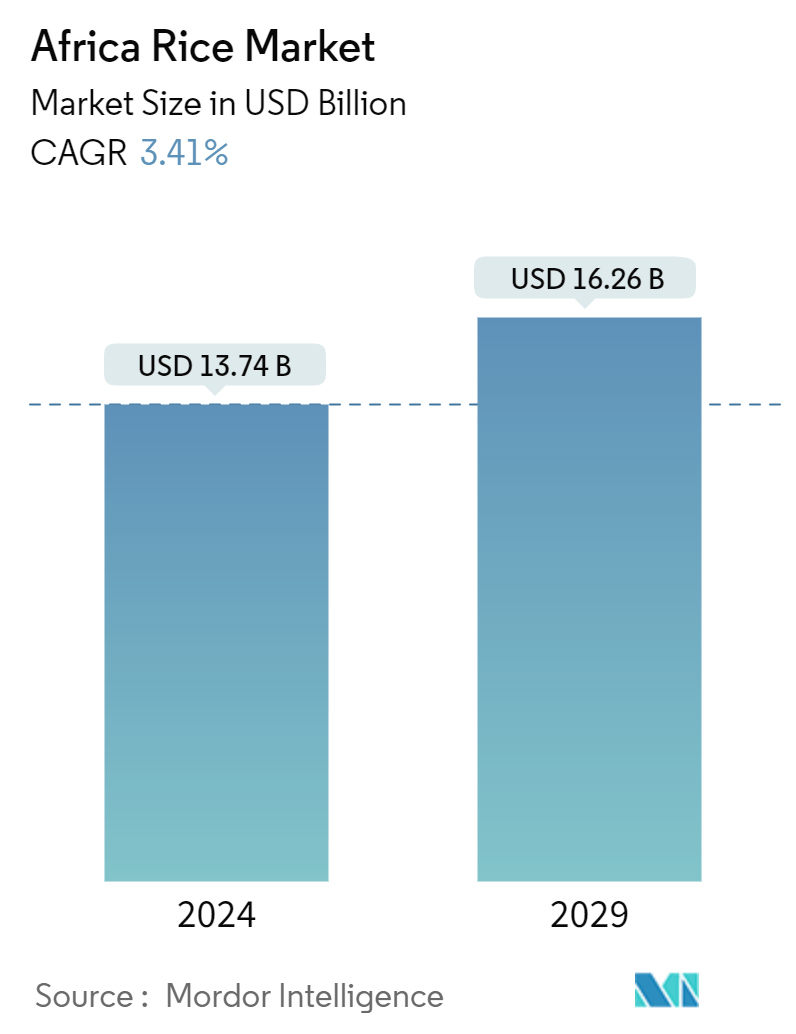Market Size of Africa Rice Industry

| Study Period | 2019 - 2029 |
| Base Year For Estimation | 2023 |
| Forecast Data Period | 2024 - 2029 |
| Market Size (2024) | USD 13.74 Billion |
| Market Size (2029) | USD 16.26 Billion |
| CAGR (2024 - 2029) | 3.41 % |
Africa Rice Market Analysis
The Africa Rice Market size is estimated at USD 13.74 billion in 2024, and is expected to reach USD 16.26 billion by 2029, growing at a CAGR of 3.41% during the forecast period (2024-2029).
- Rice has emerged as a crucial staple in Africa, with demand surging from about 10 million metric tons in 1990 to over 40 million metric tons in 2023. This increase is largely attributed to rapid population growth and evolving dietary habits, notably a rise in caloric intake from rice, from 7% to 9%. Despite yield improvements, Africa's rice production lags behind demand, resulting in increased dependence on imports. According to ITC Trade Map, over 20% of the continent's rice demand is met through imports, primarily sourced from Southeast Asia and India. This dependence on external sources renders Africa vulnerable to supply disruptions and price fluctuations.
- In Africa, rice cultivation is predominantly undertaken by smallholder farmers. In contrast, large-scale firms and trading companies contribute about 10% to the total production. The region's primary rice producers are Nigeria, Cote D'lvoire, Madagascar, Mali, and Tanzania. While these nations benefit from favorable climatic conditions for rice cultivation, rising domestic consumption is predominantly met through imports. A significant shift in consumer preferences, especially in West Africa, has intensified the regional supply and demand imbalance, propelling the rice market's growth.
Africa Rice Industry Segmentation
Rice is the staple food of more than half of the African population. The report contains an analysis of the various parameters of the African rice market. The study considers the rice after threshing and winnowing, which is mainly used for human consumption.
The African rice market is segmented by geography (South Africa, Ghana, Nigeria, Cote D'lvoire, Cameroon, Madagascar, Niger, Ivory Coast, Senegal, Guinea Bissau, Tanzania, and Uganda). The report offers a detailed analysis of the market's production (volume), consumption (volume and value), export (volume and value), import (volume and value), and price trend. The report offers market estimation and forecast in value (USD) and volume (metric tons) for the segments mentioned above.
| By Geography (Production Analysis by Volume, Consumption Analysis by Volume and Value, Import Analysis by Volume and Value, Export Analysis by Volume and Value, and Price Trend Analysis) | |
| South Africa | |
| Ghana | |
| Nigeria | |
| Cote D'lvoire | |
| Cameroon | |
| Madagascar | |
| Niger | |
| Ivory Coast | |
| Senegal | |
| Guinea Bissau | |
| Tanzania |
Africa Rice Market Size Summary
The rice market in Africa is experiencing a dynamic phase characterized by a growing demand and evolving consumer preferences. The region's reliance on rice imports is significant due to the limited self-sufficiency in domestic production, a situation exacerbated by the COVID-19 pandemic which disrupted global supply chains and led to increased prices. Despite these challenges, rice cultivation in Africa is predominantly managed by smallholder farmers, with some large-scale firms contributing to the market through partial vertical integration. Urbanization and changes in family structures, particularly the increased participation of women in the workforce, have shifted consumer preferences towards convenience foods like rice, further driving demand. Major rice-producing countries in the region include Nigeria, Cote D'lvoire, Madagascar, Mali, and Tanzania, with favorable climatic conditions supporting cultivation. However, the imbalance between supply and demand, particularly in West Africa, continues to necessitate substantial imports.
Efforts to enhance domestic rice production are underway, supported by initiatives such as the Global Agro-ecological Zones (GAEZ) project, which identifies suitable land for rice cultivation. Investments in artificial irrigation and contract farming arrangements between millers and smallholder farmers are also contributing to increased production. The demand for rice as a staple food is rising, driven by population growth and changing dietary patterns, particularly among the middle-income class. In Cote d'Ivoire, despite local production meeting only half of the domestic consumption, initiatives like the Boundiali Rice Sector Performance Improvement (BRISPI) project aim to boost local production and food security. However, the sector remains informal and fragmented, posing challenges to competitiveness against imported rice. As rice continues to be a major dietary component, imports are expected to remain a crucial aspect of the market in the foreseeable future.
Africa Rice Market Size - Table of Contents
-
1. MARKET DYNAMICS
-
1.1 Market Overview
-
1.2 Market Drivers
-
1.3 Market Restraints
-
1.4 Value Chain Analysis
-
-
2. MARKET SEGMENTATION
-
2.1 By Geography (Production Analysis by Volume, Consumption Analysis by Volume and Value, Import Analysis by Volume and Value, Export Analysis by Volume and Value, and Price Trend Analysis)
-
2.1.1 South Africa
-
2.1.2 Ghana
-
2.1.3 Nigeria
-
2.1.4 Cote D'lvoire
-
2.1.5 Cameroon
-
2.1.6 Madagascar
-
2.1.7 Niger
-
2.1.8 Ivory Coast
-
2.1.9 Senegal
-
2.1.10 Guinea Bissau
-
2.1.11 Tanzania
-
-
Africa Rice Market Size FAQs
How big is the Africa Rice Market?
The Africa Rice Market size is expected to reach USD 13.74 billion in 2024 and grow at a CAGR of 3.41% to reach USD 16.26 billion by 2029.
What is the current Africa Rice Market size?
In 2024, the Africa Rice Market size is expected to reach USD 13.74 billion.

